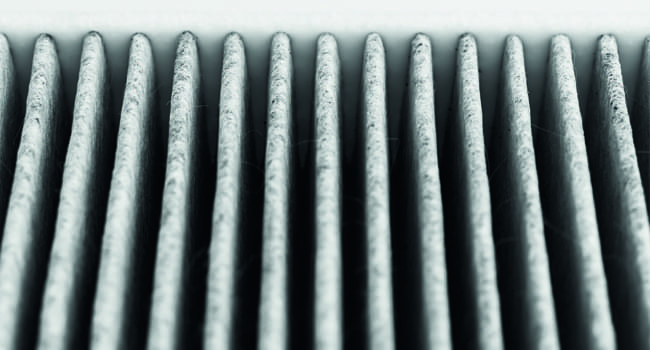In 2020, Covid-19 made meltblown one of the most desired nonwovens in the world. It seems that meltblown filter media, with an added electrostatic charge, is the most effective way to filter the Covid-19 virus in a face mask. The demand for these face masks increased by over 1000%, as did meltblown media used in them, according to a new market report from Smithers,
The Future of Meltblown Nonwovens to 2026.
Until 2020, meltblown was a specialty nonwoven, known for its ability to deliver the finest diameter fibre web of any other major nonwoven process. Its major end-uses were in filtration, where its fine pore structure could filter out the smallest particulates; sorbents, where its high surface area absorbs and holds hydrocarbons; and insulation, where its ability to exclude liquids but pass vapour makes it breathable.
Volume and value of meltblown nonwovens
The global consumption of meltblown nonwovens in 2021 is 361,600 tonnes or 7 billion m2, valued at $1.6 billion.
Growth rates for the material for 2021–26 reflect an expected market correction and are forecast at -3.5% (tonnes), -6.1% (m2), and -6.4% ($). A review of the total 2016–26 growth rates, which minimize the effects of Covid-19, shows 6.4% (tonnes), 6.8% (m2), and 6.1% ($), which are close to historical growth rates for meltblown nonwovens, the report from Smithers identifies. Excess production and inventory built up in 2020 and 2021 will result in a “correction” most likely in 2022, Smithers says, with suppliers running inventory levels down to some degree. There is some overcapacity developed in 2020-21, which will require action; closing older lines or reducing price are some options.
Regional production
Meltblown was never a large volume nonwoven (~3% of nonwovens) and by 2019 most production was in Asia. Covid-19 not only increased demand ten-fold, but also almost entirely stopped inter-regional trade. North America and Europe experienced severe shortages and producers struggled to add capacity in these regions. By 2021, forecasts are for a return to normal consumption patterns and levels in the 2022-26 period. This means a return to historically important end-uses as well.
Regulation of meltblown nonwovens
There are groups of regulations which are under consideration or in place globally which affect meltblown nonwovens: EN 14683/ASTM F2100-19 Face mask material standards, EN 149 (FFP1, FFP2, FFP3) Face mask performance standards, EURO 6, China 6, EPA Emissions standards (fuel filtration), and ISO 14644-1 (Clean room standards). Face mask performance standards are strictly regulated and vary from one country to the next. For instance, the European Standards (EN) are different than the standards for North America that are set by National Institute of Occupational Safety and Health (NIOSH) and the Centre for Disease Control (CDC).
Face masks are rated by performance. One classification is defined by European Standard EN14683:2005, which uses three specific tests – Bacterial Filtration Efficiency, Breathing Resistance, and Splash Resistance – to classify face masks as either Type I, IR, II, or IIR; with the R classes requiring splash resistance. Flammability and sub-micron particulate filtration are other properties often documented for face masks. ASTM F2100-19 is similar in intent to EN 14683. The EN 149 standard defines performance requirements for three classes of particle filtering face masks: FFP1, FFP2 and FFP3. The protection provided by an FFP2 (or FFP3) mask includes the protection provided by a mask of the lower-numbered classes. A mask conforming to the standard must have its class written on it, along with the name of the standard and its year of publication, as well as any applicable option codes.
Emission standards for fuel filtration
Increased fuel efficiency and lower emissions comes in part from a cleaner fuel supply, and cleaner fuel relies on meltblown nonwovens for filtration. EURO 6, China 6, EPA Emissions standards are all regulations with the ultimate of minimising emissions, both particulate and gases.
In addressing emissions, the high pressure common rail (HPCR) fuel injection system was developed which provides more complete combustion providing higher miles per gallon as well as less un-combusted fuel (emissions). Before the HPCR systems, electronically controlled unit injectors were and still are used; these systems have nozzle opening dimeters of 6-7 microns; HPCR nozzle opening diameters are 2-3 micron. Fuel recommendations for electronically controlled unit injectors have a cleanliness requirement, as defined by ISO4406, of no more than 50 kilograms of particulate matter pumped through per year; some HPCR systems require no more than 0.4 kilograms of particulate matter per year.
Without HPCR, diesel engines will find it very difficult to meet continually strengthening emission standards. The fuel injection designers are continually providing injectors with smaller tolerances and tighter fits, so emissions can be eliminated. This means less particulates, smaller particulates and even specific types of particulates in the fuel. For example, micro-fibreglass provides better filtration performance, but shedding of fiberglass fibres or pieces of fibre can seriously damage an injector. There are diverging thoughts on more fiberglass in fuel filtres. Fine fibre meltblown, either alone or in combination (not composites) with other materials are useful here and may be even more useful in the future. Meltblown based on polymers other than polypropylene, with better temperature and hydrocarbon resistance are especially favoured.
Find out more
